Moles, or nevi, are on the body of every person. With age, new formations may appear. In most cases, nevi are flat and do not cause any problems. Sometimes, however, hanging moles form, which is quite unpleasant from an aesthetic point of view, especially if they are located on exposed areas of the skin, such as the neck and face.
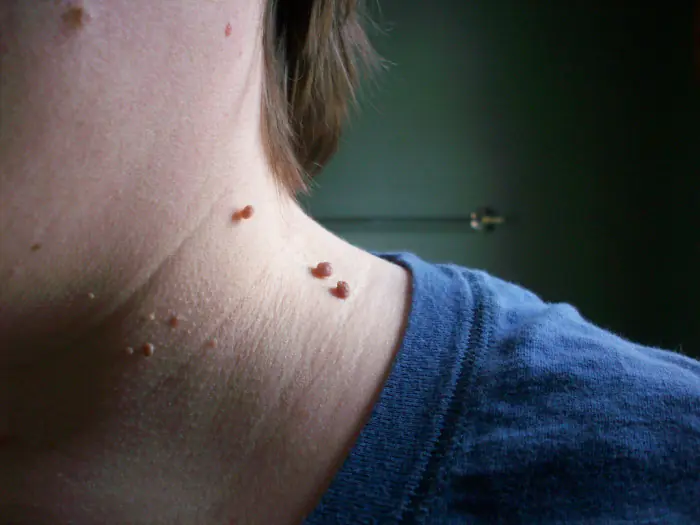
Nevus formation
The basis of the mechanism of formation of pigment spots is a disruption in the functioning of melanoblasts. The latter are cells responsible for the production of the pigment melanin, which determines the color of the skin and individual areas of the skin on the body. Disruption of the functioning of melanoblasts can occur during the period of intrauterine development of the child.
As a consequence of pathological changes, melanin is distributed unevenly throughout the skin cells, which leads to the grouping of age spots in different areas of the skin. Doctors explain the formation of nevi as a genetically determined defect of the epidermis.
Risk group
First of all, this includes women - they develop similar neoplasms much more often than men. The cause of nevus is, as a rule, high levels of estrogen. The risk is also higher in people with very fair and sensitive skin. You should not spend long periods of time in the sun without high SPF protection. People with burns, both thermal and chemical, are also at risk.

Benign neoplasms
Hanging moles are considered benign formations. However, under the influence of certain negative factors, such as ultraviolet radiation, mechanical damage, etc., cells can undergo mutation and trigger the development of melanoma.
Why do hanging moles appear on the neck? The skin in this area has a high degree of sensitivity to negative external influences, which explains the greatest likelihood of developing nevi on it.
Types of moles
There are several types of nevi. Their difference may lie in shape, as well as in size. The risk of a mole degenerating into melanoma is quite high. The most common types of nevi are:
1. Hanging. Moles in the neck area are neoplasms in the shape of a papilla. Their color is often flesh-colored. Hanging moles on the body protrude above the surface of the skin, to which they hold with a thin base. This type of mole can appear in a person at any age. In medical practice, cases of the appearance of hanging nevi in newborns have been recorded. In terms of external characteristics, they resemble papillomas, but the structure of these formations differs. The danger of hanging nevi is that they are easily injured, which can provoke mutation and degeneration into melanoma.
2. Reds. They are also called angiomas. Unlike others, these formations arise as a result of enlarged blood vessels, which causes their red tint. Such age spots occur mostly in children. Such formations are not typical for adults. Scientists see a relationship between angiomas and infectious diseases that a woman suffered during pregnancy.

A hanging mole often appears under the armpit. The reasons for its appearance are ultraviolet light that reaches the skin, hormonal fluctuations (adolescence or pregnancy - neoplasms often appear at this time), HPV, and heredity.
Types of pigmented moles
Another type of nevus is pigmented moles. They, in turn, are divided into the following types:
1. Lentigo. This is a solid color spot that can be either light or dark brown. Moles of this type are flat and do not protrude above the surface of the skin. Quite often they are mistaken for freckles.
2. Specific or complex nevi. They are distinguished by their dark color and convex structure. Their peculiarity is that they are located not only on the surface, but also on the inner layer of the epidermis.
3. Intradermal nevus. Has a smooth or rough surface. This mole is characterized by the appearance of hairs on its surface.
4. Sotton's spots. These age spots appear suddenly and also disappear unexpectedly. A significant difference between Sotton's spots and other types of moles is the specific halo that forms from discolored skin. Spots rarely degenerate into malignant neoplasms.
5. Blue moles. As the name implies, they are distinguished by their blue color, as well as their small size, reaching a maximum of 2 mm. All nevi are blue in color and have an even shape. Most often they appear on the face and neck.
6. Congenital nevi. They appear on the child’s body immediately after birth and grow with him.
Causes of moles
The exact reasons for the appearance of nevi on the human body are not yet known. However, there are factors that, according to research, can provoke the formation of nevi:
1. Ultraviolet radiation. In excess, it leads to changes in skin pigmentation. Prolonged exposure to direct sunlight can cause disruption in the functioning of melanoblasts. What else can cause hanging moles to appear?
2. Failure in human hormonal balance. Nevi appear quite often during pregnancy and adolescence, which is due to pronounced hormonal changes.
3. Predisposition at the genetic level. It is not uncommon for parents and children to develop moles in the same place. But the formation of moles is not always explained by heredity. The appearance of a nevus can be triggered by various factors, including the individual characteristics of the body.
4. Skin damage. Injuring the same area of skin several times can lead to cell mutation and, as a result, to the formation of pigment spots.

The danger of hanging moles is that there is a high risk of their degeneration into melanoma.
Causes
Melanomas arise as a result of the active proliferation of cells that are responsible for the production of melanocytes. This process is activated under the influence of the following factors:
1. Long-term exposure to ultraviolet radiation.
2. Damage to the area of skin where the moles are located. Hanging moles in the neck area are especially dangerous, as they are easily injured by jewelry or clothing.
3. Hormonal imbalance.
4. Malignant neoplasm. The causes of hanging moles should be determined by a doctor.

When to see a doctor?
The following symptoms are considered reasons to seek advice from a specialist:
1. Active growth of a mole.
2. Change in the color of the pigment spot, especially in the case of black and dark blue nevi.
3. The mole has become rough.
4. Bleeding of the neoplasm.
5. Inflammation of a mole.
6. A halo has appeared around the tumor.
The above signs may indicate the onset of cell mutation, which in the future will cause melanoma. However, sometimes the cause of itching and inflammation can be quite banal - wearing uncomfortable, tight clothes that rub against the nevus.
How to remove a hanging mole?
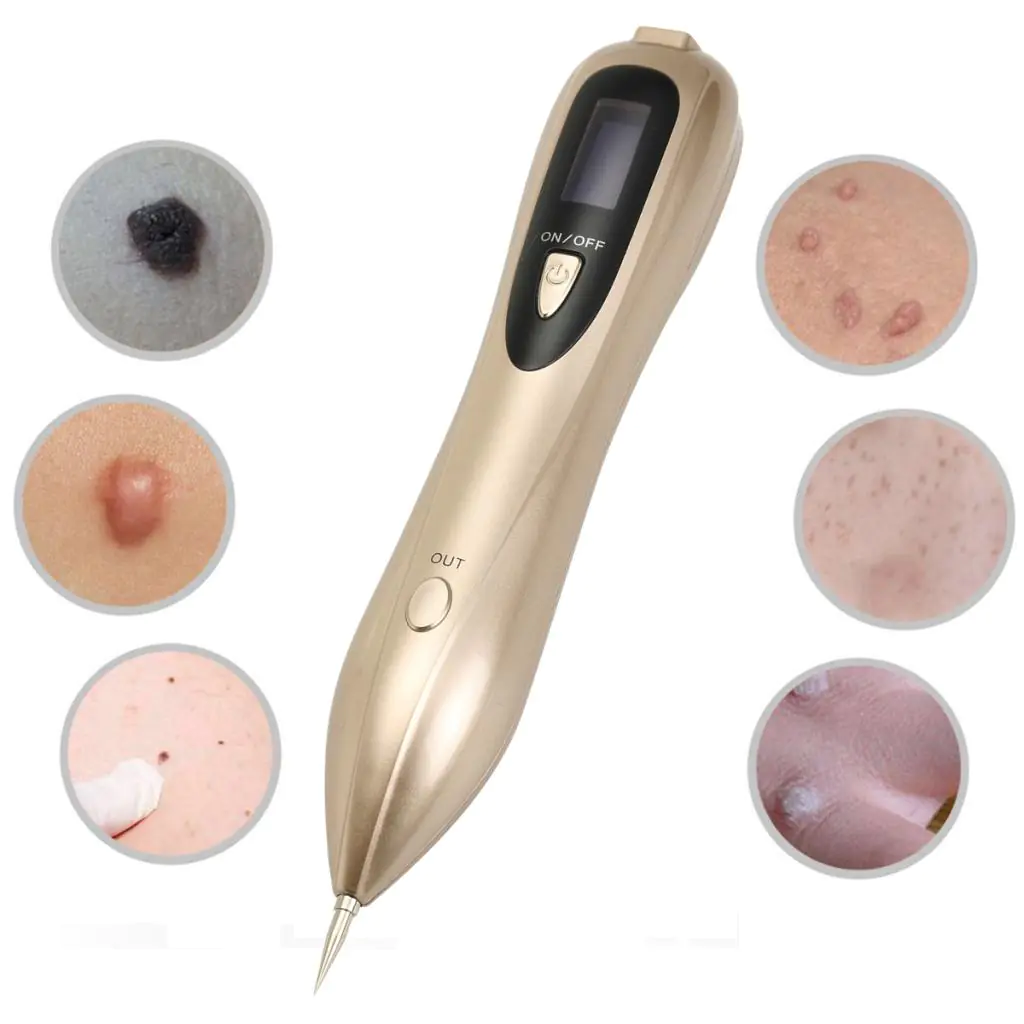
Nevus removal
Pigment spots are removed only if the degeneration of the mole into a malignant neoplasm is confirmed. Sometimes surgeons remove a mole at the request of the patient, even if there are no indications for this procedure. There are several methods:
1. Laser removal. It is prescribed if it is necessary to remove a mole with a flat surface. The laser sequentially burns out layers of skin in the area where the tumor is located. Removal is carried out under local anesthesia and does not actually cause damage to healthy areas of skin that are located around the nevus.
2. Electrocoagulation. Mole removal occurs by exposing the affected area to high-frequency current.
3. Cryodestruction. Used in cases where there is a need to remove a hanging mole. The procedure is carried out using liquid nitrogen. Under the influence of low temperatures, the cells die and the mole can be removed.
4. Tissue excision. This method can be used for any formation. In this way, it is possible to achieve not only complete removal of the mole, but also prevent possible relapses. After the excision, a scar remains in the place where the mole was.

Treatment at home
There are several methods for removing a nevus yourself. Special medications can be bought in pharmacies. They are drugs that have a freezing and necrotizing effect. In addition, you can use traditional medicine methods, namely:
1. Celandine. It is an affordable and effective means for removing moles. To do this, celandine juice is applied to the surface of the nevus twice a day. When a black dot forms at the application site, you should stop treatment and wait two weeks, during which the growth dries and falls off.
2. Soda. A paste of this product is applied to the mole for two weeks. Each time you need to wait until it dries and then wash it off. The procedure is repeated twice a day.
3. Garlic. Fresh juice should be used to treat the mole. It is necessary to avoid contact with healthy skin. For night compresses, you can use garlic soaked in vinegar for two weeks.
4. Iodine. This antiseptic also has a drying effect. Iodine can get rid of moles if applied twice a day.
conclusions
Such moles themselves do not cause discomfort to a person. In some cases, they disappear on their own without the use of surgical treatments. However, it should be borne in mind that such growths on the skin require special attention, as they can mutate into a malignant neoplasm.
So, we have looked at the reasons for the appearance of hanging moles.

Moles on the human body are often benign neoplasms that arise due to the accumulation of melanin in skin cells. An excess of the pigment present usually occurs under the influence of ultraviolet radiation. Therefore, moles can most often be found in people who abuse tanning and live in hot countries. Among the most common locations for this tumor are the face, neck and back.
Causes
Moles on the neck can appear at any age. In most cases they occur in children. Such moles can be of any size (small, medium and large), be of different types (red mole, flat, hanging, convex, etc.) and have different colors (from pale beige to deep brown).
The causes of moles on the neck may be the following:
- Hereditary factor.
- Diseases of internal organs.
- Hormonal changes.
- Frequent trips to the solarium.
- Abuse of sunbathing.
- As a result of injury to the baby's skin in the womb.
What does a mole on the neck mean?

When a mole appears on the neck, some people look for the meaning of this neoplasm. It is generally accepted that moles located in this place show that their owner has a rich spiritual world, has a lively mind and developed consciousness. A mole on a man’s neck indicates that he has business acumen and a high degree of entrepreneurship.
Women who have a mole on their neck have kindness, tenderness and natural softness. As a rule, they are excellent housewives, capable of adding coziness and comfort to their home. They are excellent cooks and can raise a child properly. At the same time, a mole on the neck may indicate a changeable character.
A mole on a child's neck means that he enjoys great love and favor from his parents. Such children are often everyone's favorites. Everyone pampers them and indulges them in everything. Quite often this leads to the child being completely unadapted to life in the future.
If a mole is on the right side of the neck, it indicates that its owner is a realist in life. If it is located on the left, the person is an incorrigible romantic who often flies “in the clouds.” If a person has many moles on his neck, this means that he is monogamous.
Are moles on the neck dangerous?
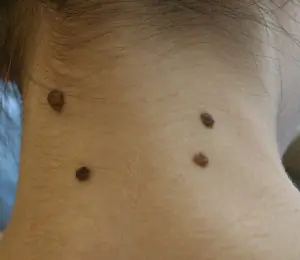
If a mole on the neck does not spoil the appearance, is flat and small in size, in most cases it cannot be removed. It is necessary to get rid of moles in the following cases:
- If a mole grows on the neck, especially if the tumor grows quite rapidly.
- The mole hurts on the neck and the area around it is inflamed.
- A mole on the neck itches and flakes off.
- Bleeding and swelling appeared in the problem area.
- Sudden color change. The mole may turn black.
- Changing the shape of the tumor.
Removing moles on the neck
Large moles on the neck, which are most susceptible to degeneration, are to be removed first. The method of removing the present tumor is selected by a specialist doctor. Among the methods available today are:
- Laser mole removal is carried out by burning out the neoplasm with a laser.
- Surgical excision of a mole is a full-fledged operation. It occurs under local anesthesia and is performed using surgical instruments.
- The electrocoagulation method allows you to effectively and quickly remove moles using high-frequency electric current.
- Cryodestruction today is a rather outdated method along with surgical excision. The procedure is carried out using liquid nitrogen. The problem area is frozen, resulting in the destruction of the mole tissue. In its place, a bubble first appears, which after a few days becomes covered with a crust. Among the disadvantages of the method: possible burns and scars.
- Radio wave exposure carried out using a special device. Over the course of several sessions, the mole is irradiated, subsequently it decreases in size and becomes lighter. After a few weeks, the mole disappears.
Possible consequences
If you do not remove a problematic mole in time or remove a tumor that does not need to be touched, this can lead to undesirable consequences. Among them, the most serious is the risk of a mole degenerating into a malignant tumor and the development of skin cancer.
Possible consequences of mole removal include:
- Infection that can enter the bloodstream through a wound.
- Appearance of scars.
- Inflammation of the wound.
To avoid the above consequences, you must contact qualified doctors. The area of skin where the mole was located after its removal must be treated with special ointments and wiped with tinctures prescribed by the doctor.
Moles and birthmarks are hyperpigmented areas of skin formed by melanocytes. The growths may vary in size and color, rise above the surrounding skin, or appear as a dark, flat dot. Every person has nevi, they increase with age, and in some cases degenerate into a malignant form. A mole on the neck can be intradermal, papillomatous or fibroepithelial.
Reasons for the formation of moles
The main reason for the appearance of nevi is a hereditary predisposition. In young children they may not be noticeable, but as they grow older the skin stretches and the moles become larger. Pigmented neoplasms can appear in large numbers during puberty, pregnancy, and menopause.
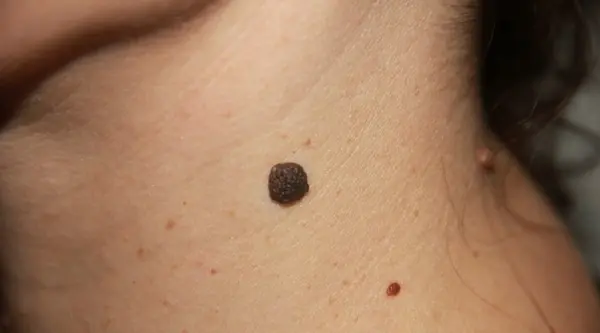
Why moles appear on the neck:
- prolonged exposure to direct sunlight;
- hormonal imbalance;
- frequent skin injury;
- autoimmune diseases;
- skin infections, acne, rashes;
- radiation, x-rays.
Depending on the location, moles on the neck are intradermal, with melanocytes located in the deep dermal layer of the skin. The epidermal type is characterized by an accumulation of pigmented cells in the upper epidermis, the borderline type is characterized by the presence of melanocytes at the border of the dermis and epidermis. An intradermal mole on the neck on the right or left looks like a convex pea, a border nevus looks like a smooth, dark spot.
The color of the new growths varies from flesh-colored to black-violet. A red tint indicates the presence of small blood vessels. Small growths usually do not pose any threat, but if they are hanging, they can be injured by the collar of clothing, bleed, or become infected. Some large moles can degenerate into a malignant form (melanoma) with constant mechanical impact and solar insolation.
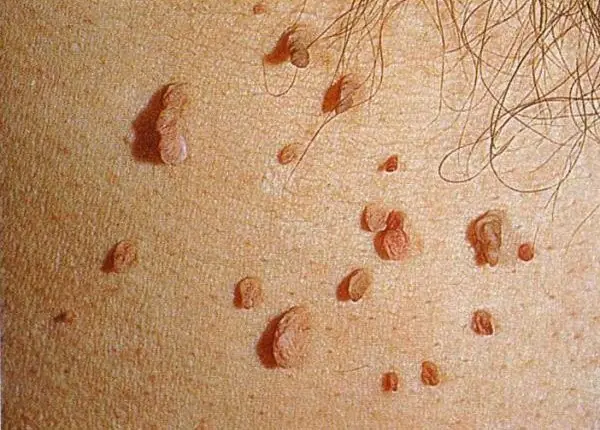
A hanging mole on the neck in the middle or in the back is an oblong outgrowth of the epidermis. It has a soft consistency, flesh-colored or pink, less often brown. This nevus appears after prolonged exposure to ultraviolet rays. A similar clinical picture is presented by papillomas that grow after a person is infected with papillomavirus; the main difference is a thin stalk at the base of the growth. Both neoplasms bleed easily when mechanically damaged, so if a mole is often rubbed by the collar, it must be removed.
Diagnostics
The patient is examined by a dermatologist or oncologist. The doctor determines the type of nevus, selects treatment tactics, and eliminates the possibility of malignancy. The number of moles that appear, color, size, and consistency are important. The doctor asks if the patient is bothered by discomfort (pain, itching), bleeding, discoloration, fluid secretion, and how quickly the growth grows in size.
Additionally, dermatoscopy, phosphorus isotope analysis, echography, X-ray, and thermometry are performed. To identify cancer cells, a piece of tissue is taken for a biopsy.
Treatment options
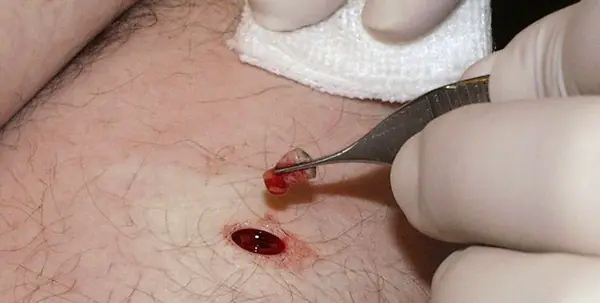
A large melanoma-dangerous mole cannot be removed cosmetically; excision should only be carried out surgically after an examination. In most cases, nevi cause aesthetic discomfort and inconvenience to people. You can get rid of tumors in the following ways:
- electrocoagulation;
- cryodestruction;
- laser removal;
- radiosurgery;
- classic excision with a scalpel.
The removal method is selected by the doctor, taking into account the size and type of nevus. The least traumatic of them is laser exposure; after evaporation of the liquid by a carbon dioxide beam, rapid tissue healing occurs, there is no bleeding, and no scars remain.
If many moles appear on the neck, you should not try to get rid of them on your own. The skin in this area is very delicate, well supplied with blood; if it is damaged, a bacterial infection can occur, an ulcer, suppuration, or abscess may form. In addition, multiple convex growths can be caused by papillomavirus. In such cases, therapy with immunomodulators and vitamins are required, otherwise the disease will recur.
The appearance of a large number of moles is also observed in cases of hormonal disorders in a child during adolescence, during pregnancy, and after menopause. In people suffering from thyroid diseases, diabetes mellitus, a dark spot or mole forms on the back of the neck, in the armpits, inguinal folds, on the bends of the elbows, on the forehead along the hairline. Patients with such symptoms should consult an endocrinologist.
If nevi appear on the neck, you cannot use folk remedies for treatment without first consulting a dermatologist.
Signs of melanoma
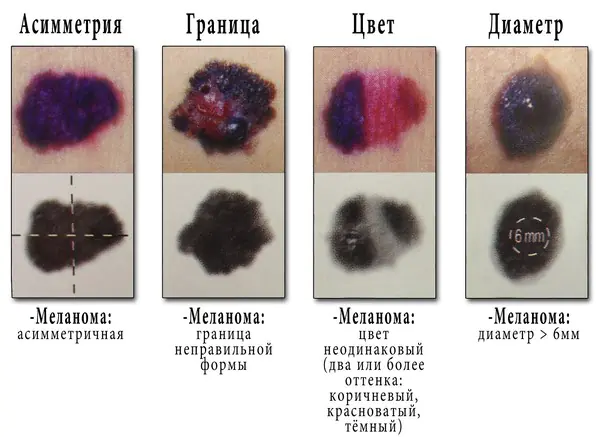
You can suspect the formation of a cancerous tumor based on the following symptoms:
- rapid increase in the size of a mole more than 6 mm in diameter;
- pain on palpation;
- itching;
- secretion of ichor;
- ulceration, formation of a crust on top of the growth;
- the appearance of a black dot on a mole;
- irregular shape, unclear edges.
The first sign of melanoma is the growth of a mole, change in color and shape.
Preventing the appearance of new moles
To prevent new moles from growing on the neck, the following rules must be followed:
- avoid prolonged exposure to the sun;
- monitor the level of hormonal balance, see an endocrinologist;
- refuse to visit the solarium;
- Visit a dermatologist periodically if you have large moles on your body or a large birthmark on your neck.
During a summer holiday by the sea, you should visit the beach in the afternoon, when the sun's rays are less aggressive on the skin, and use creams with a high degree of UV protection. If you experience symptoms of nevus degeneration, you should immediately consult a doctor, since melanoma can very quickly metastasize to almost all internal organs.



